托福听写作业21
新托福独立写作21类题目

新托福独立写作21类题目1.体育类:2008.11.14—Children should only play sports for fun rather than play sports in competitions or contests. (Education)孩子们应该为了乐趣而去参加体育活动而不是为了竞争或者比赛。
体育在现代生活的重要性有:1.体育可以在身体得到锻炼,使身体素质得到提高;2.体育活动让朋友和家人聚集一起参加锻炼,有社会意义,是一种积极的休闲和团体活动;3.体育可以调节生活,让人们获得心理上的健康和快乐,更好的缓解压力;4.体育可以提高人的意志和韧性;5.体育是一个大的产业,给国家带来收入;6.体育体现了人类社会的精神,可以促进世界和平。
体育运动的优点:1.增加体质(increase physical strength),有益于身心健康;2.加快脂肪燃烧(accelerate fat burning),有助于减肥(lose weight);3.有助于保持体形(stay in shape),提高自我的形象(improve self image);4.有助于缓解压力(relieve stress),调节心情(improve mood),减少失落的情绪(reduce the chance of depression);5.有助于保持旺盛的精力(keep energetic),从而提高工作效率(increase productivity)。
孩子参加体育项目是为了获得快乐:因为体育活动可以让他们得到精神上的放松,可以是他们和朋友交流的一种方式;而获得乐趣并不是体育活动的唯一目的,参加比赛也是一种目的,因为比赛获胜可以让他们获得一种成就感,输了可以学会逆境成长的精神。
2008.12.5—Sports teaches us lessons about life.运动教会我们一些生活道理运动教会我们要养成健康的生活方式和积极的人生态度;体育比赛告诉我们竞争是生活的一部分,但友谊同样重要;团队运动教给人们要合作,在生活中和工作中也要学会合作,这样做事情才会能有效率,比如,在足球篮球比赛中,你不能时时都争着进球,要注意合作才能获得更高的分数,一个全都是优秀球员的球队并不一定能给打败一个球员很平庸但是合作的很好的球队,在生活上也是如此,我们不必事事争第一,和别人合作往往能达到共赢的目的。
托福听力21
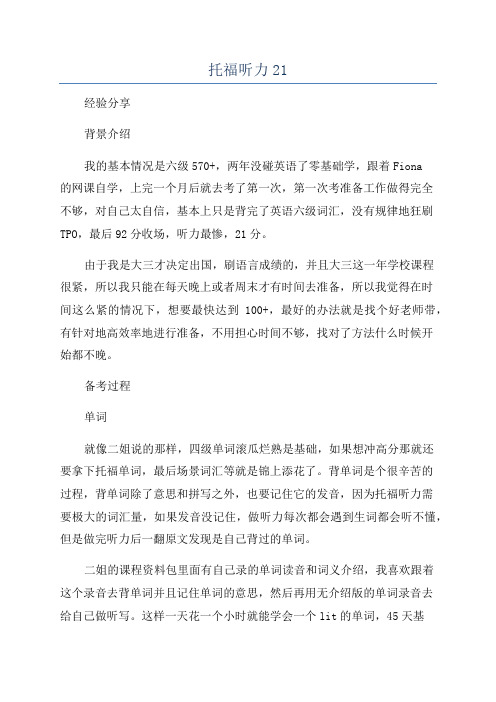
托福听力21经验分享背景介绍我的基本情况是六级570+,两年没碰英语了零基础学,跟着Fiona的网课自学,上完一个月后就去考了第一次,第一次考准备工作做得完全不够,对自己太自信,基本上只是背完了英语六级词汇,没有规律地狂刷TPO,最后92分收场,听力最惨,21分。
由于我是大三才决定出国,刷语言成绩的,并且大三这一年学校课程很紧,所以我只能在每天晚上或者周末才有时间去准备,所以我觉得在时间这么紧的情况下,想要最快达到100+,最好的办法就是找个好老师带,有针对地高效率地进行准备,不用担心时间不够,找对了方法什么时候开始都不晚。
备考过程单词就像二姐说的那样,四级单词滚瓜烂熟是基础,如果想冲高分那就还要拿下托福单词,最后场景词汇等就是锦上添花了。
背单词是个很辛苦的过程,背单词除了意思和拼写之外,也要记住它的发音,因为托福听力需要极大的词汇量,如果发音没记住,做听力每次都会遇到生词都会听不懂,但是做完听力后一翻原文发现是自己背过的单词。
二姐的课程资料包里面有自己录的单词读音和词义介绍,我喜欢跟着这个录音去背单词并且记住单词的意思,然后再用无介绍版的单词录音去给自己做听写。
这样一天花一个小时就能学会一个lit的单词,45天基本上就能记住大部分单词了,然后再查漏补缺就行。
背单词一定不能懈怠,最好养成每天背单词的习惯!r、>口语口语可以说是二姐的特色课程了,跟着老师说的去做,把该背的模板和素材背好,记好答题流程和逻辑,然后定期抽出时间做一下TPO题,这个不会花太多时间,慢慢熟练了就行。
口语部分我还是完全相信老师的,事实证明老师给的素材简直万能,两次考试的tak1都逃不出素材的范围。
tak2-tak4都有涉及听力的部分,这部分我是尽可能多做笔记,用一些符号或者简写单词的方式,想方设法多记笔记。
可能很多第一次考托福的同学在做口语的时候都会手忙脚乱,担心规定的时间内说不完所有内容,所以就顾不上语速和语法句法,卡顿还多,但其实就算在规定的时间内说不完所有内容影响也不会太大,所以考试时平稳心态,想清楚了再说,冷静下来最重要。
TPO21听力答案的解析
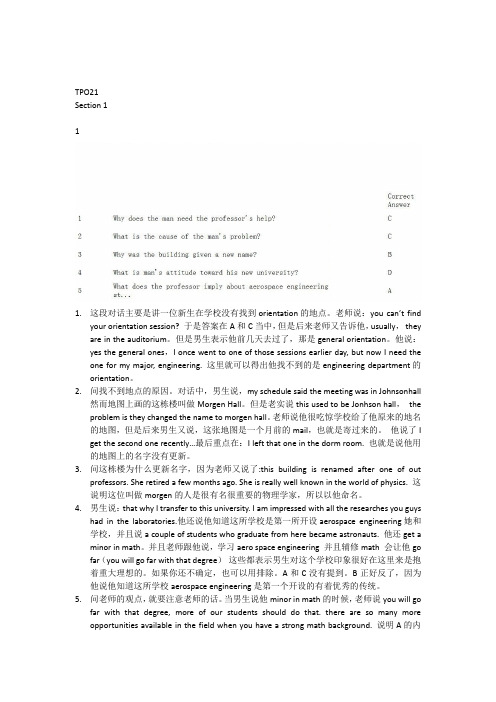
TPO21Section 111.这段对话主要是讲一位新生在学校没有找到orientation的地点。
老师说:you can’t findyour orientation session? 于是答案在A和C当中,但是后来老师又告诉他,usually,they are in the auditorium。
但是男生表示他前几天去过了,那是general orientation。
他说:yes the general ones,I once went to one of those sessions earlier day, but now I need the one for my major, engineering. 这里就可以得出他找不到的是engineering department的orientation。
2.问找不到地点的原因。
对话中,男生说,my schedule said the meeting was in Johnsonhall然而地图上画的这栋楼叫做Morgen Hall。
但是老实说this used to be Jonhson hall,the problem is they changed the name to morgen hall。
老师说他很吃惊学校给了他原来的地名的地图,但是后来男生又说,这张地图是一个月前的mail,也就是寄过来的。
他说了I get the second one recently…最后重点在:I left that one in the dorm room. 也就是说他用的地图上的名字没有更新。
3.问这栋楼为什么更新名字,因为老师又说了:this building is renamed after one of outprofessors. She retired a few months ago. She is really well known in the world of physics. 这说明这位叫做morgen的人是很有名很重要的物理学家,所以以他命名。
托福TPO21口语Task6听力文本+题目+满分范文

为了帮助大家高效备考托福,为大家带来托福TPO21口语Task6听力文本+题目+满分范文,希望对大家备考有所帮助。
托福TPO21口语Task6听力文本: Listen to a part of a lecture from a history class. The professor is talking about the Industrial Revolution. (female professor) Back in the18th century, in a time known as the Industrial Revolution, some countries, well, England in particular, started using new technology, like steam-powered machines to produce goods. And the use of these machines brought about some significant changes. Let's go over two main changes that occurred.One change was that the center of production moved from homes to factories. Um, let's take fabric, or cloth, as an example. Historically, for a very long time, people had made cloth by hand in their homes, earning a little money from their home-based cloth production. But then these new steam-powered machines for weaving cloth were invented and placed in factories, and these machines could weave cloth much more quickly and efficiently. So there wasn't any reason to keep making cloth slowly in homes when it could be made faster on factory machines. Thus the majority of cloth productions shifted from home-based businesses to factory production. Another result of the new technology is that cities started forming around factories, like let’s say there was a cloth factor y that was built in a certain small village. Now, of course, the factor y needed workers to operate the machines used in cloth production. So the factory would hire a lot of rural workers who would then move from the country side to the village. So instead of spreading all over the country side, the workers started to congregate in the village with the factory. As a result, the village got bigger and bigger and eventually grew to a city. 托福TPO21口语Task6题目: Using points and examples from the talk, describe two changes that occurred after machines began to be used for manufacturing goods. 托福TPO21口语Task6满分范文: The first change was that the manufacturing center has shifted from home to factory. Before the invention of machine, people made their product, like fabric cloth, by hand at home, which was slow and not very efficient. However, when the machine was introduced, it was faster and it could wave cloth more quickly and efficiently, so factories soon replaced the home-based production businesses and became the center of production. Another result is that cities began to form around factories. When a factory was built in a village, it would need workers to operate the cloth machine. So the farmers who used to live in the countryside then would have to move to the village. And they started to congregate there. As a result,the villagegrew bigger and bigger and finally turned into a city. (136 words) 以上是给大家整理的托福TPO21口语Task6听力文本+题目+满分范文,希望对你有所帮助!。
TPO21综合写作听力阅读范文独立写作范文托福写作机经

TPO21综合写作听力阅读范文独立写作范文托福写作机经TPO21综合写作:Reading:Genetic modifications, a process used to change an organism's genes and hence its characteristics, is now being used to improve trees. Through genetic modification, it is possible to create trees that produce more fruit, grow faster, or withstand adverse conditions. Planning genetically modified trees on a large scale promises to bring a number of benefits.First, genetically modified trees are designed to be hardier than natural trees; that is, they are more likely to survive than their unmodified counterparts. In Hawaii, for example, a new pest-resistant species of payapa tree has been developed in response to ringshot virus infections that have repeatedly damaged the native papaya-tree population. Planning the genetically modified papayas has largely put an end to the ringshot problem. Moreover, genetically modified trees promise to bring a number of economic benefits to those who grow then. Genetically modified trees tend to grow faster, give greater yields of food, fruit, or other products- and be hardier. This allows tree farmers to get faster and greater returns on their farming investment and save on pesticides as well. [hardy: resistant to cold, 耐寒]Finally, the use of genetically modified trees can prevent overexploitation of wild trees. Because of the growing demand for firewood or building timber, many forests around the world are being cut down faster than they can be replaced. Introducing genetically modified trees designed for fast growth and highyield in given geographic conditions would satisfy the demand for wood in many of those areas and save the endangered native trees, which often include unique or rare species.Lecture:Sure, there are some benefits of planting genetically modified trees, but are these trees really as great as they first sound? When you examine the subject closely, here are some serious problems and costs associated with using genetically modified trees.First, genetically modified trees may be resistant to one particular condition, but that does not necessarily ensure their survival. You see, a typical non-modified tree population is genetically diverse. That means that, for most threatening conditions, for climates, insects and other pests, whatever, there will be at least some individual trees or any given species of trees that are resisted. So even if most of one kind of tree are killed, those few resisted ones will survive and ensure the survival of that species of tree. But genetically modified trees are genetically much more uniformed, so if they are exposed to an environmental challenge they have not been designed for, they will all die. So if the climate changes or a new pest invades the area, the genetically modified trees will likely be completely wiped out.Now as the second point, there are hidden costs associated with growing genetically modified trees. You see, the companies that genetically modified the trees tend to charge farmers much more for each seed than unmodified tree seeds would cost. Also, as you've grown the tree, you cannot collect the seeds and plant a new tree for free. By law, you have to pay the company every time you plant.And finally, genetically modified trees might actually cause even more damage to the local wild trees. You see, genetically modified trees are often grown more aggressively than natural trees do. And genetically modified trees are typically planted among natural trees. As a result, the genetically modified trees out compete the native trees for resources: sunlight, soil, nutrients and water, eventually crowding out the natural trees.Integrated writing sample essay:The professor claims that there are serious problems and costs associated with planting genetically modified trees, challenging the view in the reading passage that planting genetically modified trees on a large scale promises to bring tremendous benefits.First, the passage says that genetic modification is a good way to protect the trees against harsh natural conditions or possible infections because they are designed to be hardier. However, the lecturer claims that genetic modification does not ensure their survival because these trees are genetically more unified. So, if their genes are not designed for a particular condition, such as climate change or invasion of new pests, they might be eradicated altogether.Second, the passage says that genetically modified trees tend to grow faster, give more fruits and therefore provide greater financial returns for the growers. However, the lecturer points out that this is not the whole picture, because the seeds of genetically modified trees are more costly and the law requires farmers to pay for the company for every genetically modified tree that is planted.Finally, the passage says that genetic modification is a good solution for the protection of wild trees from overexploitation.But the professor points out that these trees are genetically more aggressive and typically planted among the natural trees. They might out compete the natural trees for natural resources and eventually edge them out.独立写作:For future career success, is the ability to relate well to other people more important than studying hard at school?1P: 咩个人都渴望获得success,但成功需要付出extraordinary efforts,而且还需要an element of luck和一定的社会关系;因为这是一个强调团队合作和cooperation的时代。
托福TPO21综合写作阅读原文+听力原文+满分范文

¡¡¡¡ÎªÁË°ïÖú´ó¼Ò¸ßЧ±¸¿¼Íи££¬Îª´ó¼Ò´øÀ´Íи£TPO21×ÛºÏд×÷ÔĶÁÔ-ÎÄ+ÌýÁ¦Ô-ÎÄ+Âú·Ö·¶ÎÄ£¬Ï£Íû¶Ô´ó¼Ò±¸¿¼ÓÐËù°ïÖú¡£¡¡¡¡Íи£TPO21×ÛºÏд×÷ÔĶÁÔ-ÎÄÎı¾£º¡¡¡¡Genetic modification, a process used to change an organism¡¯s genes and hence its characteristics, is now being used to improve trees through genetic modification. It is possible to create trees that produce more fruit, grow faster, or withstand adverse conditions. Planting genetically modified trees on a large scale promises to bring a number of benefits. First, genetically modified trees are designed to be hardier than nature trees; that is, they are more likely to survive than their unmodified counterparts. In Hawaii, for example, a new pest-resistant species of papaya trees has been developed in response to ring spot virus infections that have repeatedly damaged the native papaya tree population. Planting the genetically modified papayas has largely put an end to the ringspot problem. Moreover, genetically modified trees promise to bring a number of economic benefits to those who grow them. Genetically modified trees tend to grow faster, give greater yields of food, fruit, or other products and be hardier. This allows tree farmer to get faster and greater returns on their farming investment and save on pesticides as well. Finally, the use of genetically modified trees can prevent overexploitation of wild trees. Because of the growing demand for firewood and building timber, many forests around the world are being cut down faster than they can be replaced. Introducing genetically modified trees,designed for fast growth and high yield in given geographic conditions,would satisfy the demand for wood in many of those areas and save the endangered native trees, which often include unique or rare species.¡¡¡¡Íи£TPO21×ÛºÏд×÷ÌýÁ¦Ô-ÎÄÎı¾£º¡¡¡¡Sure, there are some benefits to plant genetically modified trees, but, are these trees as really great as they first sound? When you examine the subject firstly, there are some serious problems and costs associated with genetically modified trees.First, genetically modified trees may be resistant to one particular condition. But that doesn't necessarily ensure their survival. You see, a typical non modified trees' population is genetically diverse. That means that for most threatening conditions, or climate, insects and other pests, whatever, there will be at least some individual trees of any given species of tree that are resistant. So even if most of one kind of trees are killed, those few resistant trees will survive and ensure the survival of that species of tree. But genetically modified trees are genetically much more uniform. So if they're exposed to an environmental challenge they have not been designed for, they all die. So if the climate changes, the genetically modified trees will likely to be completely wiped out.Now as to the second point, they're hidden costs associated with genetically modified trees. You see, the company that genetically modifies the tree can charge tree farmers more for its seeds than un-genetically modified trees would cost. Also, as you've grown the tree, you can't justcollect the seeds and plant the new tree for free. By law, you have to pay the company every time you plant.And finally, genetically modified trees might actually cause even more damage to the local wild trees. You see, genetically modified trees often grow more aggressively than natural trees do. And, genetically modified trees are typically planted among natural trees. As a result, the genetically modified trees outcompete the native trees for resources, sunlight, soil, nutrients, and water, eventually crowding out the natural trees.¡¡¡¡Íи£TPO21×ÛºÏд×÷Âú·Ö·¶ÎÄ1£º¡¡¡¡In the lecture, the professor claims that although they may be some benefit, planting genetic modified trees will bring potential problems and costs. She totally opposes the three statements made in the reading passage. Firstly, the professor indicates that genetic modified trees may resistant, but this cannot guarantee their survival. She points out that in fact the unity of genes within genetic modified plantwill increase their likelihood to wipe out when there is some threatening situation.The professor counters the claim made by the reading passage. Secondly, the professor opposes the reading passage by pointing out there is hidden cost behind modification trees. Though genetic modification trees may provide more products or can save pesticide, their seeds are usually charged at a higher price. In addition, accordingto the law, a farmer has to pay for the seed each time they plant the trees. Thiswill not bring any economic benefit mentioned in the reading passage. Last but not least, the professor opposes the statement that genetic modification trees will prevent overexploit of wild trees. In fact, genetic modification trees tend to grow aggressively and can easily exhaust the resource of normal trees. This will bring disastrous result for the local vegetation.¡¡¡¡Íи£TPO21×ÛºÏд×÷Âú·Ö·¶ÎÄ2£º¡¡¡¡In the reading, the author claim that planting genetically modified trees can bring a number of benefits. However, in the lecture, the professor states that although there might be some benefits, planting genetic modified trees will bring serious problems and costs. Firstly, the professor indicates that genetic modified trees may be resistant to certain conditions as the reading states, but this cannot guarantee their survival. She points out that in fact the uniform genes of these genetically modified trees may lead them to be wiped out when facing unfavorable conditions suchas climate changes, while some of the ordinary trees might be able to survive. Secondly, the professor opposes the reading passage by pointing out there is hidden cost behind modification trees. Though genetic modification trees may have higher yields or need less pesticide, their seeds are usually charged at a higher price.In addition, according to the law, a farmer has to pay for the seed each time they plant the trees. L ast but not least, the professor opposes the statement that genetic modification trees will prevent overexploit of wild trees. In fact, genetic modification trees tend to grow aggressively and can easily exhaust the resource of。
iBT独立写作 TPO 21

21. Do you agree or disagree with the following statement? For success in a future job, the ability to relate well to people is more important than studying hard in school. Use specific reasons and examples to support your answer.As a student in a complex society, we should learn the necessary knowledge in the school as well as the capability to relate well with other people. It is too simplistic to say which is more important between social skills and learning ability. I agree with this statement with reserved for several reasons. However, in terms of job, I prefer the ability to relate well to people is more essential in the long run than studying hard.Admittedly, as a student in school, the primarily purpose is studying and acquire the basic knowledge. This is because this learning ability will lay a solid foundation for our future development even though we probably forget most of them. Otherwise, the social skills in the future job is like a building a skyscraper lack of cement and bricks. Take a business negotiation as an example. You can not achieve a great success only with your negotiation skills when you deal with others in the situation that you lack expertise knowledge about your product. Therefore, I regard studying in school as the foundation to your future success.Further, the meaning of the ability to relate well to people in the job is significantly outweigh the specific knowledge you acquired. Specifically, everyone is interrelated and interdependent with others and this relationship requires you should equip with sophisticated communicating skills and social skills if you want to be a remarkable person in your job. This could be best illustrated with my country's culture. There is an old saying in my country: drinking ability is more essential than price in a business deal. Therefore, with deep-rooted intertwine relationship among this society; you must have the ability to relate well with your partner or companion beside your basic knowledge.What is more, there are lots of tasks that could be accomplished by different kinds of specialist and proficient. Nevertheless, to be a success leader in job, you must have the ability to communicate and coordinate with your team members with your sophisticated skills. According to the survey, most technology company boss even do not know the basic computer knowledge but they can be the boss and made their company increasingly giant due to their ability to relate well to people. That is to say, studying hard in school could make you require expertise in one domain but you never could be a great leader if you lacking the ability of social skills.Having considered all the discussion above, both of these aspects are crucial to a person's success in the future job, but I suppose that the former capability could make you fulfill higher achievement.。
托福写作tpo21综合写作范文
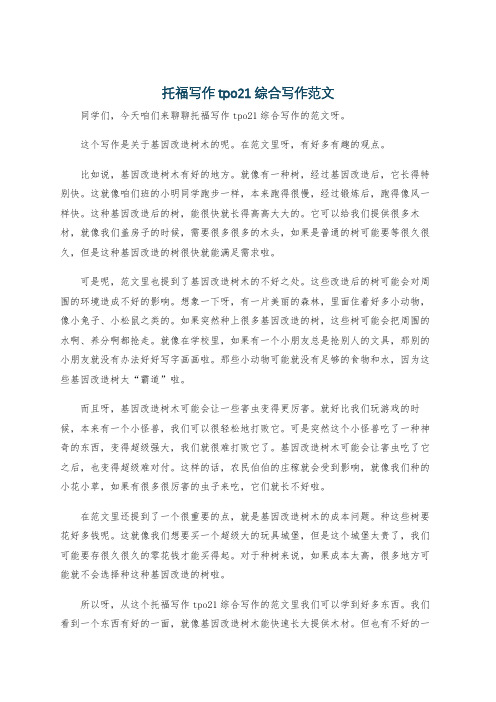
托福写作tpo21综合写作范文同学们,今天咱们来聊聊托福写作tpo21综合写作的范文呀。
这个写作是关于基因改造树木的呢。
在范文里呀,有好多有趣的观点。
比如说,基因改造树木有好的地方。
就像有一种树,经过基因改造后,它长得特别快。
这就像咱们班的小明同学跑步一样,本来跑得很慢,经过锻炼后,跑得像风一样快。
这种基因改造后的树,能很快就长得高高大大的。
它可以给我们提供很多木材,就像我们盖房子的时候,需要很多很多的木头,如果是普通的树可能要等很久很久,但是这种基因改造的树很快就能满足需求啦。
可是呢,范文里也提到了基因改造树木的不好之处。
这些改造后的树可能会对周围的环境造成不好的影响。
想象一下呀,有一片美丽的森林,里面住着好多小动物,像小兔子、小松鼠之类的。
如果突然种上很多基因改造的树,这些树可能会把周围的水啊、养分啊都抢走。
就像在学校里,如果有一个小朋友总是抢别人的文具,那别的小朋友就没有办法好好写字画画啦。
那些小动物可能就没有足够的食物和水,因为这些基因改造树太“霸道”啦。
而且呀,基因改造树木可能会让一些害虫变得更厉害。
就好比我们玩游戏的时候,本来有一个小怪兽,我们可以很轻松地打败它。
可是突然这个小怪兽吃了一种神奇的东西,变得超级强大,我们就很难打败它了。
基因改造树木可能会让害虫吃了它之后,也变得超级难对付。
这样的话,农民伯伯的庄稼就会受到影响,就像我们种的小花小草,如果有很多很厉害的虫子来吃,它们就长不好啦。
在范文里还提到了一个很重要的点,就是基因改造树木的成本问题。
种这些树要花好多钱呢。
这就像我们想要买一个超级大的玩具城堡,但是这个城堡太贵了,我们可能要存很久很久的零花钱才能买得起。
对于种树来说,如果成本太高,很多地方可能就不会选择种这种基因改造的树啦。
所以呀,从这个托福写作tpo21综合写作的范文里我们可以学到好多东西。
我们看到一个东西有好的一面,就像基因改造树木能快速长大提供木材。
但也有不好的一面,像影响环境、让害虫变强大、成本高。
托福-练习二十一_真题-无答案(294)

托福-练习二十一(总分30,考试时间90分钟)Passage 1Read the passages and choose the best answer to each question.1. In classical and medieval times, the study of music shared many features with the discipline of mathematics, such as an interest in proportions, special ratios, and recurring patterns. In the twentieth century, the introduction of twelve-tone music and the widespread use of computers inspired further study into the relationship between musical and mathematical abilities. Musical performances require sensitivity to ratios that are **plex, and to appreciate the operation of rhythms, a performer must have some basic **petence.1. Which of the following can be inferred from the passage?A. The disciplines of music and mathematics originated in classical times.B. People have long been aware of links between music and mathematics.C. Both music and mathematics require an understanding of computers.D. Professional musicians must study mathematics at the university level.1 Some people believe that odors and fragrances affect the body and mind and are capable of healing anxiety, stress, and other sources of disease. Interest in aromatherapy-- and the use of aromatherapy products such as lotions and inhalants--continues to boom. Some popular essential oils and their uses in aromatherapy include lavender and chamomile, which are reputed to ease stress and promote sleep. The scent of jasmine will uplift the mood and reduce depression. Orange eases anxiety and depression and promotes creativity. Peppermint has antibacterial and analgesic qualities, eases mental fatigue, and relieves headaches.2 However, aromatherapy is not for everyone. For people who suffer from fragrance sensitivity, asthma, or allergies, aromas like perfumes can prompt disabling health problems, including headaches, dizziness, nausea and vomiting, fatigue, difficulty breathing, difficulty concentrating, flu-like symptoms, and anaphylaxis.2. It can be inferred that aromatherapy isA. the main use of essential oils from plantsB. the use of certain scents to promote healthC. not recommended for treating headachesD. not an effective method of curing disease3. All of the following fragrances are believed to reduce stress EXCEPTA. avenderB. jasmineC. chamomileD. orange4. Corvids are sociable and tend to form social groups. This is particularly true of rooks, which stay in their flocks all year round. The raven, largest of the corvids, joins a social group as a juvenile, pairing off at around the age of three and mating for life. Courtship can involve such games as pair snow sliding and the synchronized flight test. Corvids can be found all over the world. The adaptability and intelligence of this family have made them extremely successful. For centuries, the raven and the crow have held a special place in the mythology of various cultures.2. It can be inferred from the passage that corvids areA. a family of birdsB. games for childrenC. members of a sports clubD. imaginary beings5. The input of solar energy supplies 99 percent of the energy needed to heat the earth and all buildings on it. How is this possible? Most people think of solar energy in terms of direct heat from the sun. However, broadly defined, solar energy includes direct energy from the sun as well as a number of indirect forms of energy produced by this direct input. Major indirect forms of solar energy include wind, hydropower, and biomass--solar energy converted to chemical energy in trees, plants, and other organic matter.3. It can be inferred from the passage that the author most likely believes which of the following about solar energy?A. Solar energy is not used as much as it could be used.B. It is not possible to develop direct forms of solar energy.C. Trees, plants, and organic matter can store solar energy.D. The definition of solar energy will continue to chang1 Animal behaviorists believe the orangutan is a cultured ape, able to learn new living habits and to pass them along to the next generation. Some orangutan parents teach their young to use leaves as napkins, while others demonstrate the technique of getting water from a hole by dipping a branch in and then licking the leaves. Orangutans have been observed saying goodnight with the gift of a juicy raspberry. Such social interactions lead researchers to conclude that if orangutans have culture, then the capacity to learn culture is very ancient.2 In the evolutionary timeline, orangutans separated from the ancestors of humans many millions of years ago, and they may have had culture before they separated. The discovery of orangutan culture suggests that early primates--including ancestors of humans--might have developed the ability to invent new behaviors, such as tool use, as early as 14 million years ago, approximately 6 million years earlier than once believed.6. What can be inferred from paragraph 1 about social interactions related to teaching andlearning?A. They are behaviors that only orangutans have displayed.B. They are misunderstood by animal behaviorists.C. They indicate similarities between orangutans and other apes.D. They provide evidence that orangutans have cultur7. Which of the following can be inferred from paragraph 2?A. The ancestors of humans learned culture from orangutans.B. Orangutans were more advanced than most other early primates.C. Primate culture may be older than scientists used to believe.D. Scientists have found orangutan tools that are 6 million years olOne of the most significant elements of age stratification in all cultures is the pattern of experiences connected to marriage and parenting--a pattern that sociologists call the family life cycle. In North America, about 90 percent of adults marry, and the great majority of them have children and thus a family life cycle related to family experiences. When the family's first child is born, the parents embark on a sequence of experiences linked to the child's development--from infancy and toddlerhood, through school age and adolescence, and eventually, to departure from the nest. Each of these periods in the child's life makes a different set of demands on the parents.8. The phrase embark on in the passage is closest in meaning toA. ttemptB. beginC. iscussD. avoid9. It can be inferred from the passage that the family life cycleA. takes place whether or not people have childrenB. does not occur in cultures outside of North AmericaC. must be redefined from one generation to the nextD. shapes several years in the lives of most adults10. The reasons for the migration from rural to urban life were exploitation and lack of economic opportunity. The family members who would not inherit a share in the property were exploited by the laws of inheritance. The system was particularly hard on women, who usually did not share in the ownership of the farm and who rarely were paid for their labor. The workday for women was even more demanding than it was for men. Women were responsible for the kitchen garden and the small livestock as well as the care of the family. Unmarried women increasingly left the farm in search of economic opportunity in the factories that processed fish or farm products.4. It can be inferred from the passage that women under this systemA. moved from farm to farm in search of workB. were paid less than men for the same workC. did not acquire property through inheritanceD. had to get married in order to stay on the farmPassage 2Read the passages and choose the best answer to each question.1 In the early nineteenth century, most of the Europeans who immigrated to the United States were from northern and western European countries such as England, Germany, France, and Sweden. However, most of the fifteen million Europeans arriving between 1890 and 1914 came from southern and eastern Europe, with the largest **ing from Russia, Italy, Greece, Austria-Hungary, and Armenia.2 A similar pattern occurred in Canada, where most immigrants were traditionally from England and the United States. After 1890, an increasing number came from eastern Europe, particularly Russia and Ukraine. Many of these headed for the Prairie Provinces. The Doukhobors, a pacifist sect from southern Russia, **munal settlements in Saskatchewan. Together with other immigrants, they arrived in such numbers that in the two decades between **pletion of the main railroad network and the outbreak of war in 1914, the population of the prairies had increased from about 150,000 to 1.5 million.1. Which of the following can be inferred from paragraph 1 about European immigration to the United States in the nineteenth century?A. The sources of immigrants shifted to different parts of Europe.B. Most of the European immigrants could not speak English.C. More immigrants came from Europe than from other continents.D. Northern and western Europeans did not immigrate after 1890.2. It can be inferred from paragraph 2 that the DoukhoborsA. were the largest immigrant group in North AmericaB. also immigrated to the United StatesC. mainly settled in the Canadian prairiesD. helped to build Canada's railroad network1 David Smith worked primarily in iron, exploring its possibilities more fully than any other sculptor before or since. To Smith, iron spoke of the power, mobility, and vigor of the industrial age. Smith was born in Indiana in 1906, the descendant of a nineteenth- century blacksmith. His iron sculptures flowed naturally out of the mechanized heart of America, a landscape of railroads and factories. As a child, Smith played on trains and around factories, as well as in nature on hills and near creeks. He originally wanted to be a painter, but after seeing photographs of the metal sculpture of Picasso in an art magazine, he began to realize that iron could be handled as directly as paint.2 Many of Smith's sculptures are "totems" that suggest variations on the human figure. They are not large iron dolls, although several have "heads" or "legs." Still, they forcefully convey posture and gesture. Their message flows from the internal relations of the forms and from the impression of tension, spring, and alertness set up by their position in space.3 Later in his career, Smith produced two series of sculptures in stainless steel: the Sentinels in the 1950s and the Cubis in the 1960s. He also began placing his sculptures outdoors, in natural light, where the highly reflective stainless steel could bring sunlight and color into the work. In the late afternoon sun, the steel planes of the Cubis reflect a golden color; at other times, they have a blue cast. The mirror-like steel creates an illusion of depth, which responds better tosunshine than it would to the static lighting of a museum.3. The word vigor in paragraph 1 is closest in meaning toA. historyB. povertyC. lifestyleD. strength4. Which of the following can be inferred from paragraph 1 about David Smith's background?A. He gained experience while working in a blacksmith factory.B. His childhood exposed him to the uses and possibilities of iron.C. His early sculptures revealed his desire to be a landscape painter.D. He first learned about metals by seeing pictures in a magazin5. What can be inferred about the Sentinels and the Cubis?A. They are the best-known examples of Smith's "totem" sculptures.B. Smith originally intended to use iron instead of stainless steel.C. The Sentinels are made of blue steel, and the Cubis are of gold steel.D. They each consist of a number of pieces placed in outdoor settings.6. It can be inferred from the passage that the author most likely believes which of the following about David Smith's works?A. His metal sculptures are more interesting than are those of Picasso.B. His sculptures attempt to portray the proportions of the human body.C. His pieces capture the power of industry and the beauty of natural light.D. His works are best appreciated when viewed all at once in a museum.1 Long ago, people looked up in the sky and noticed groups of stars that looked like pictures. These patterns of stars, constellations, have been part of human culture for thousands of years. Ancient Syrians and Babylonians named many constellations and created stories about them. The Greeks and Romans later adopted these constellations and translated their names and stories into their own language. After the decline of these ancient cultures, most knowledge of constellations remained hidden in private libraries. Beginning in the eighth century, scholars rediscovered this knowledge. The study of astronomy spread quickly throughout the Mediterranean world, becoming part of university study. Astronomers identified many constellations only a few centuries ago. When Western astronomers started traveling to South Africa in the seventeenth century, they found numerous brilliant stars in the Southern sky. They named some of these Southern constellations after the scientific inventions of the time, such as the Microscope and the Air Pump.2 Today's astronomers view constellations simply as areas of the sky where interesting objects await observation and study. The entire sky is divided into 88 such regions. In the 1920s, the International Astronomical Union established the boundaries of these regions. In each region, astronomers give Greek letters to a constellation's brighter stars, usually in order of brightness. Hence, the "alpha star" is the brightest star of that constellation. Scientists and ordinary people still refer to many constellations by their popular names, for example, the Lion, the Hunter, and the Great Bear.7. Which of the following can be inferred from paragraph 1?A. Constellations have interested people for a very long time.B. People once believed incorrect stories about constellations.C. Ancient cultures disagreed about the shapes of constellations.D. Most knowledge of constellations has been lost forever.8. It can be inferred from paragraph 1 that the ancient Greeks and RomansA. were the first people to notice patterns of stars in the skyB. built universities all over the Mediterranean regionC. hid knowledge of constellations in private librariesD. acquired knowledge of constellations from earlier cultures9. It can be inferred from paragraph 2 thatA. there are no constellations in some areas of the skyB. scientists today continue to study constellationsC. the boundaries of the constellations change every yearD. the International Astronomical Union no longer exists10. According to paragraph 2, which of the following statements is most likely true?A. Future scientists will divide the sky into fewer regions.B. There are no more constellations for scientists to discover.C. A constellation's alpha star is the one that is easiest to see.D. Few people know the traditional names of constellations.Passage 3Read the passages and choose the best answer to each question.1 The human ear contains the organ for hearing and the organ for balance. Both organs involve fluid-filled channels containing hair cells that produce electrochemical impulses when the hairs are stimulated by moving fluid.2 The ear can be divided into three regions: outer, middle, and inner. The outer ear collects sound waves and directs them to the eardrum separating the outer ear from the middle ear. The middle ear conducts sound vibrations through three small bones to the inner ear. The inner ear is a network of channels containing fluid that moves in response to sound or movement.3 To perform the function of hearing, the ear converts the energy of pressure waves moving through the air into nerve impulses that the brain perceives as sound. Vibrating objects, such as the vocal cords of a speaking person, create waves in the surrounding air. These waves cause the eardrum to vibrate with the same frequency. The three bones of the middle ear amplify and transmit the vibrations to the oval window, a membrane on the surface of the cochlea, the organ of hearing. Vibrations of the oval window produce pressure waves in the fluid inside the cochlea. Hair cells in the cochlea convert the energy of the vibrating fluid into impulses that travel along the auditory nerve to the brain.4 The organ for balance is also located in the inner ear. Sensations related to body position are generated much like sensations of sound. Hair cells in the inner ear respond to changes in head position with respect to gravity and movement. Gravity is always pulling down on the hairs, sending a constant series of impulses to the brain. When the position of the headchanges--as when the head bends forward--the force on the hair cells changes its output of nerve impulses. The brain then interprets these changes to determine the head's new position.1. What can be inferred about the organs for hearing and balance?A. Both organs evolved in humans at the same time.B. Both organs send nerve impulses to the brain.C. Both organs contain the same amount of fluid.D. Both organs are located in the ear's middle region.2. Hearing involves all of the following EXCEPTA. motion of the vocal cords so that they vibrateB. stimulation of hair cells in fluid-filled channelsC. amplification of sound vibrationsD. conversion of wave energy into nerve impulses3. It can be inferred from paragraphs 2 and 3 that the cochlea is a part ofA. the outer earB. the eardrumC. the middle earD. the inner ear4. What can be inferred from paragraph 4 about gravity?A. Gravity has an essential role in the sense of balance.B. The ear converts gravity into sound waves in the air.C. Gravity is a force that originates in the human ear.D. The organ for hearing is not subject to gravity.1 The Pacific Northwest coast of North America is a temperate rain forest, where trees like the red cedar grow straight trunks more than two meters thick at the base and sixty meters high. Western red cedar is often called the canoe cedar because it supplied the native people of the region with the raw material for their seagoing dugout canoes. These extraordinary crafts, as large as twenty meters in length, were fashioned from a single tree trunk and carried as many as forty people on fishing and whaling expeditions into the open ocean.2 The Haida people from the Queen Charlotte Islands off British Columbia were noted for their skill in canoe building. After felling a giant tree with controlled burning, the canoe makers split the log into lengthwise sections with stone wedges. They burned away some of the heartwood, leaving a rough but strong cedar shell. They then carved away wood from the inside, keeping the sections below the waterline thickest and heaviest to help keep the canoe upright in stormy seas. To further enhance the canoe's stability, they filled the hull with water and heated it to boiling by dropping in hot stones. This rendered the wood temporarily flexible, so the sides of the hull could be forced apart and held with sturdy wooden thwarts, which served as both cross braces and seats. The canoes were often painted with elaborate designs of cultural significance to the tribe.3 The Haida raised canoe building to a high art, designing boats of such beauty and utility that neighboring tribes were willing to exchange quantities of hides, meats, and oils for a Haida canoe. These graceful vessels became the tribe's chief item of export. In their swift and staunch canoes, the first people of the Northwest were able to take full advantage of the riches provided by the sea. With harpoons of yew wood, baited hooks of red cedar, and lines of twisted and braided bark fibers, they fished for cod, sturgeon, and halibut, and hunted whales, seals, andsea otters.5. The word fashioned in paragraph 1 is closest in meaning toA. thrownB. loweredC. madeD. decorated6. Why did the canoe makers keep the sections of the canoe below the waterline thickest and heaviest?A. To prevent the canoe from overturning in rough waterB. To shorten the work of carving wood from the insideC. To avoid having to paint the bottom of the canoeD. To make the canoe strong enough to hold forty people7. Which of the following can be inferred from paragraph 2?A. Carving changed the texture and strength of the wood.B. It took the canoe makers several months to build a canoe.C. The wood was beaten with stone tools to make it flexible.D. Canoes were important cultural artifacts of the Haid8. The word staunch in paragraph 3 is closest in meaning toA. silentB. strongC. scentedD. severe9. It can be inferred from paragraph 3 thatA. canoes were the Haida's only known art formB. the Haida dominated trade among local tribesC. the people used up all of the natural resourcesD. trees provided essential tools for obtaining food10. Which of the following statements can be inferred from the passage?A. The western red cedar thrives in a variety of climates.B. The skill of the Haida canoe makers has never been copied.C. Haida canoes were of great value in the regional economy.D. People no longer use cedar canoes for fishing and whalin。
TPO21 综合写作 听力 阅读 范文 独立写作 范文 托福写作机经

TPO21综合写作:Reading:Genetic modifications, a process used to change an organism's genes and hence its characteristics, is now being used to improve trees. Through genetic modification, it is possible to create trees that produce more fruit, grow faster, or withstand adverse conditions. Planning genetically modified trees on a large scale promises to bring a number of benefits.First, genetically modified trees are designed to be hardier than natural trees; that is, they are more likely to survive than their unmodified counterparts. In Hawaii, for example, a new pest-resistant species of payapa tree has been developed in response to ringshot virus infections that have repeatedly damaged the native papaya-tree population. Planning the genetically modified papayas has largely put an end to the ringshot problem. Moreover, genetically modified trees promise to bring a number of economic benefits to those who grow then. Genetically modified trees tend to grow faster, give greater yields of food, fruit, or other products- and be hardier. This allows tree farmers to get faster and greater returns on their farming investment and save on pesticides as well. [hardy: resistant to cold, 耐寒]Finally, the use of genetically modified trees can prevent overexploitation of wild trees. Because of the growing demand for firewood or building timber, many forests around the world are being cut down faster than they can be replaced. Introducing genetically modified trees designed for fast growth and high yield in given geographic conditions would satisfy the demand for wood in many of those areas and save the endangered native trees, which often include unique or rare species.Lecture:Sure, there are some benefits of planting genetically modified trees, but are these trees really as great as they first sound? When you examine the subject closely, here are some serious problems and costs associated with using genetically modified trees.First, genetically modified trees may be resistant to one particular condition, but that does not necessarily ensure their survival. You see, a typical non-modified tree population is genetically diverse. That means that, for most threatening conditions, for climates, insects and other pests, whatever, there will be at least some individual trees or any given species of trees that are resisted. So even if most of one kind of tree are killed, those few resisted ones will survive and ensure the survival of that species of tree. But genetically modified trees are genetically much more uniformed, so if they are exposed to an environmental challenge they have not been designed for, they will all die. So if the climate changes or a new pest invades the area, the genetically modified trees will likely be completely wiped out.Now as the second point, there are hidden costs associated with growing genetically modified trees. You see, the companies that genetically modified the trees tend to charge farmers much more for each seed than unmodified tree seeds would cost. Also, as you've grown the tree, you cannot collect the seeds and plant a new tree for free. By law, you have to pay the company every time you plant.And finally, genetically modified trees might actually cause even more damage to the local wild trees. You see, genetically modified trees are often grown more aggressively than natural trees do. And genetically modified trees are typically planted among natural trees. As a result, the genetically modified trees out compete the native trees for resources: sunlight, soil, nutrients and water, eventually crowding out the natural trees.Integrated writing sample essay:The professor claims that there are serious problems and costs associated with planting genetically modified trees, challenging the view in the reading passage that planting genetically modified trees on a large scale promises to bring tremendous benefits.First, the passage says that genetic modification is a good way to protect the trees against harsh natural conditions or possible infections because they are designed to be hardier. However, the lecturer claims that genetic modification does not ensure their survival because these trees are genetically more unified. So, if their genes are not designed for a particular condition, such as climate change or invasion of new pests, they might be eradicated altogether.Second, the passage says that genetically modified trees tend to grow faster, give more fruits and therefore provide greater financial returns for the growers. However, the lecturer points out that this is not the whole picture, because the seeds of genetically modified trees are more costly and the law requires farmers to pay for the company for every genetically modified tree that is planted.Finally, the passage says that genetic modification is a good solution for the protection of wild trees from overexploitation. But the professor points out that these trees are genetically more aggressive and typically planted among the natural trees. They might out compete the natural trees for natural resources and eventually edge them out.独立写作:For future career success, is the ability to relate well to other people more important than studying hard at school?1P: 咩个人都渴望获得success,但成功需要付出extraordinary efforts,而且还需要an element of luck和一定的社会关系;因为这是一个强调团队合作和cooperation的时代。
tpo21 questioning awareness of effect 解析
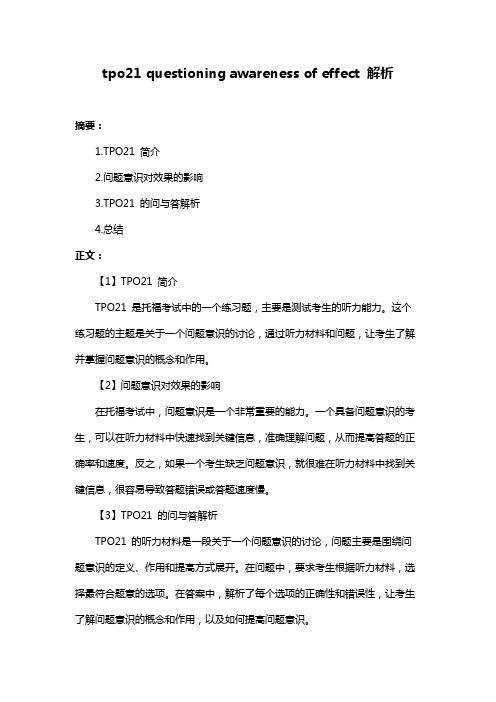
tpo21 questioning awareness of effect 解析
摘要:
1.TPO21 简介
2.问题意识对效果的影响
3.TPO21 的问与答解析
4.总结
正文:
【1】TPO21 简介
TPO21 是托福考试中的一个练习题,主要是测试考生的听力能力。
这个练习题的主题是关于一个问题意识的讨论,通过听力材料和问题,让考生了解并掌握问题意识的概念和作用。
【2】问题意识对效果的影响
在托福考试中,问题意识是一个非常重要的能力。
一个具备问题意识的考生,可以在听力材料中快速找到关键信息,准确理解问题,从而提高答题的正确率和速度。
反之,如果一个考生缺乏问题意识,就很难在听力材料中找到关键信息,很容易导致答题错误或答题速度慢。
【3】TPO21 的问与答解析
TPO21 的听力材料是一段关于一个问题意识的讨论,问题主要是围绕问题意识的定义、作用和提高方式展开。
在问题中,要求考生根据听力材料,选择最符合题意的选项。
在答案中,解析了每个选项的正确性和错误性,让考生了解问题意识的概念和作用,以及如何提高问题意识。
【4】总结
总的来说,TPO21 是一个对问题意识进行测试和训练的练习题。
托福TPO21口语Task5听力文本+题目+满分范文
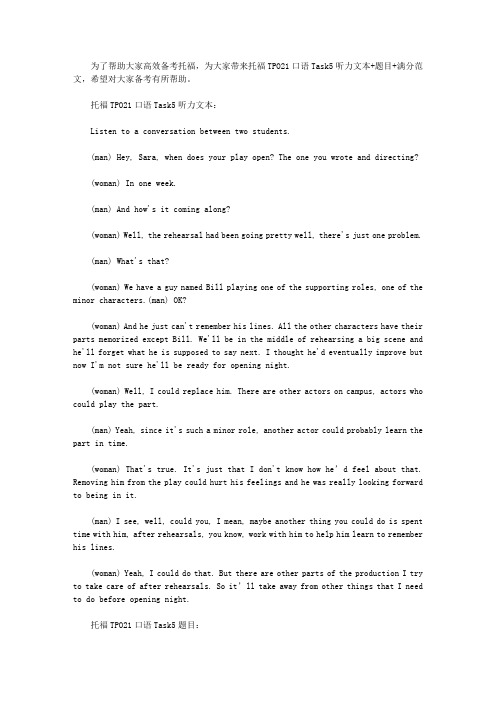
为了帮助大家高效备考托福,为大家带来托福TPO21口语Task5听力文本+题目+满分范文,希望对大家备考有所帮助。
托福TPO21口语Task5听力文本: Listen to a conversation between two students. (man) Hey, Sara, when does your play open? The one you wrote and directing? (woman) In one week. (man) And how's it coming along? (woman) Well, the rehearsal had been going pretty well, there's just one problem. (man) What's that? (woman) We have a guy named Bill playing one of the supporting roles, one of the minor characters.(man) OK? (woman) And he just can't remember his lines. All the other characters have their parts memorized except Bill. We'll be in the middle of rehearsing a big scene and he'll forget what he is supposed to say next. I thought he'd eventually improve but now I'm not sure he'll be ready for opening night. (woman) Well, I could replace him. There are other actors on campus, actors who could play the part. (man) Yeah, since it's such a minor role, another actor could probably learn the part in time. (woman) That's true. It's just that I don't know how he’d feel about that. Removing him from the play could hurt his feelings and he was really looking forward to being in it. (man) I see, well, could you, I mean, maybe another thing you could do is spent time with him, after rehearsals, you know, work with him to help him learn to remember his lines. (woman) Yeah, I could do that. But there are other parts of the production I try to take care of after rehearsals. So it’ll take away from other things that I need to do before opening night. 托福TPO21口语Task5题目: Briefly summarize the problem the speakers are discussing. Then state which solution you would recommend. Explain the reasons for your recommendation. 托福TPO21口语Task5满分范文: Well, the woman's problem is that her play will be in the middle of rehearsing a big scene but one of the supporting roles couldn't remember his lines. Accordingly, there are two solutions for the woman's problem: first she could replace the actor, and second, she could spend some time with him and help him learn to remember his lines. I think the woman should choose the second solution for two reasons. Firstly, replacing a character during the rehearsal just before the opening night is kind of cruel for the actor no matter how minor an role he plays. After all, it takes everyone's spare time and effort to get together aiming for the final show, not only the main roles but the minor ones. Secondly, I guess it'll take more time to find someone new to replace and even longer time for the new to fit in the whole team. So comparatively, do him a little favor and help him remember his lines after rehearsals would show the real team spirit and definitely will work. (178 words) 以上是给大家整理的托福TPO21口语Task5听力文本+题目+满分范文,希望对你有所帮助!。
综合写作tpo21听力原文
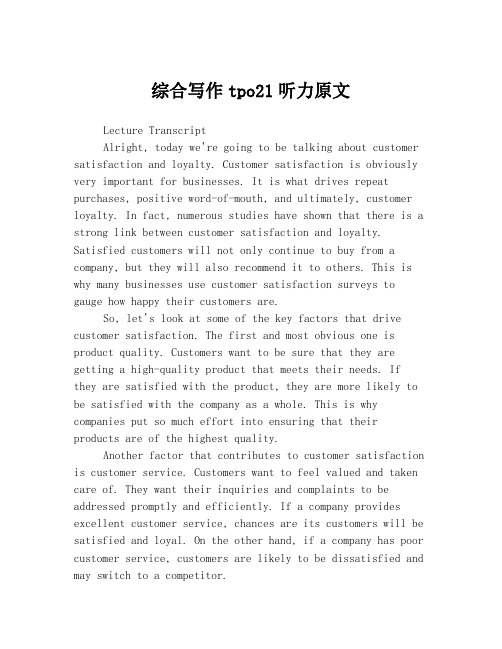
综合写作tpo21听力原文Lecture TranscriptAlright, today we're going to be talking about customer satisfaction and loyalty. Customer satisfaction is obviously very important for businesses. It is what drives repeat purchases, positive word-of-mouth, and ultimately, customer loyalty. In fact, numerous studies have shown that there is a strong link between customer satisfaction and loyalty. Satisfied customers will not only continue to buy from a company, but they will also recommend it to others. This is why many businesses use customer satisfaction surveys to gauge how happy their customers are.So, let's look at some of the key factors that drive customer satisfaction. The first and most obvious one is product quality. Customers want to be sure that they are getting a high-quality product that meets their needs. If they are satisfied with the product, they are more likely to be satisfied with the company as a whole. This is why companies put so much effort into ensuring that their products are of the highest quality.Another factor that contributes to customer satisfaction is customer service. Customers want to feel valued and taken care of. They want their inquiries and complaints to be addressed promptly and efficiently. If a company provides excellent customer service, chances are its customers will be satisfied and loyal. On the other hand, if a company has poor customer service, customers are likely to be dissatisfied and may switch to a competitor.The third factor we're going to discuss is price. Now, you might think that price is the most important factor when it comes to customer satisfaction, but that's not necessarily the case. While it is true that customers want value fortheir money, they are often willing to pay a little extra for a better product or service. So, price is important, but it's not everything.Finally, we have convenience. Nowadays, customers have a wide range of choices when it comes to where and how to shop. They want convenience and ease of use. If a company makes it easy for customers to find and purchase their products or services, they are more likely to be satisfied. Convenience includes things like user-friendly websites, convenient store locations, and efficient delivery options.In conclusion, customer satisfaction is crucial for businesses as it leads to repeat purchases, positive word-of-mouth, and customer loyalty. Product quality, customer service, price, and convenience are all important factorsthat contribute to customer satisfaction. Companies that focus on these factors are likely to have satisfied and loyal customers.。
【托福写作】托福写作21分难考吗
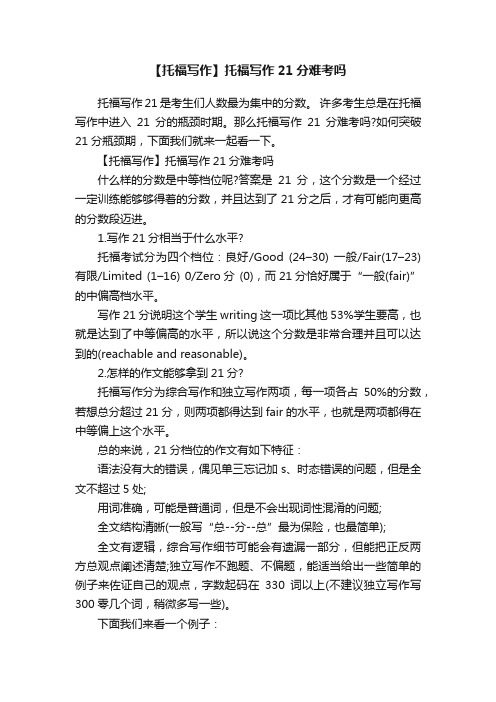
【托福写作】托福写作21分难考吗托福写作21是考生们人数最为集中的分数。
许多考生总是在托福写作中进入21分的瓶颈时期。
那么托福写作21分难考吗?如何突破21分瓶颈期,下面我们就来一起看一下。
【托福写作】托福写作21分难考吗什么样的分数是中等档位呢?答案是21分,这个分数是一个经过一定训练能够够得着的分数,并且达到了21分之后,才有可能向更高的分数段迈进。
1.写作21分相当于什么水平?托福考试分为四个档位:良好/Good (24–30) 一般/Fair(17–23) 有限/Limited (1–16) 0/Zero分 (0),而21分恰好属于“一般(fair)”的中偏高档水平。
写作21分说明这个学生writing这一项比其他53%学生要高,也就是达到了中等偏高的水平,所以说这个分数是非常合理并且可以达到的(reachable and reasonable)。
2.怎样的作文能够拿到21分?托福写作分为综合写作和独立写作两项,每一项各占50%的分数,若想总分超过21分,则两项都得达到fair的水平,也就是两项都得在中等偏上这个水平。
总的来说,21分档位的作文有如下特征:语法没有大的错误,偶见单三忘记加s、时态错误的问题,但是全文不超过5处;用词准确,可能是普通词,但是不会出现词性混淆的问题;全文结构清晰(一般写“总--分--总”最为保险,也最简单);全文有逻辑,综合写作细节可能会有遗漏一部分,但能把正反两方总观点阐述清楚;独立写作不跑题、不偏题,能适当给出一些简单的例子来佐证自己的观点,字数起码在330词以上(不建议独立写作写300零几个词,稍微多写一些)。
下面我们来看一个例子:托福写作题目:A NEW ACQUIANTANCE OF YOURS IS THINKING ABOUT STUDYING YOUR NATIVE LANGUAGE. hOW WOULD U CONVINCE HIM OR HER THAT THIS WOULD BE A GOOD DECISION? USE SPECIFIC REASONS AND DETAILS IN YOUR RESPONSE.托福写作21分例文:In my point of view, there are a lot of reasons why one should study my native language-Chinese. Here are some of them.在我看来,人们学习我的母语中文的原因很多。
托福写作tpo21综合写作范文
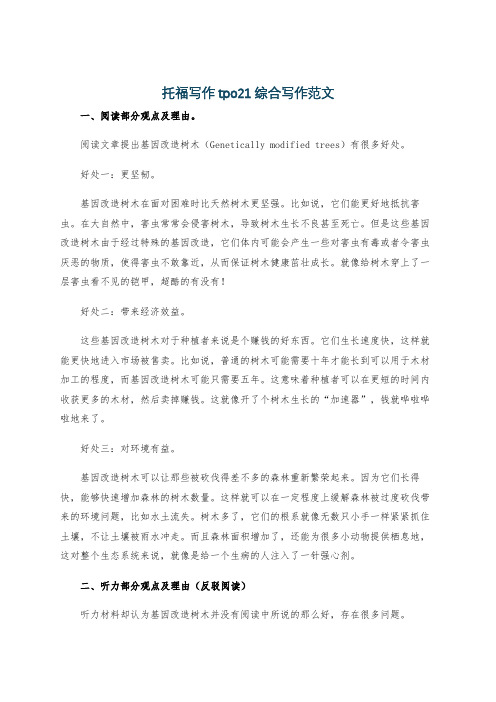
托福写作tpo21综合写作范文一、阅读部分观点及理由。
阅读文章提出基因改造树木(Genetically modified trees)有很多好处。
好处一:更坚韧。
基因改造树木在面对困难时比天然树木更坚强。
比如说,它们能更好地抵抗害虫。
在大自然中,害虫常常会侵害树木,导致树木生长不良甚至死亡。
但是这些基因改造树木由于经过特殊的基因改造,它们体内可能会产生一些对害虫有毒或者令害虫厌恶的物质,使得害虫不敢靠近,从而保证树木健康茁壮成长。
就像给树木穿上了一层害虫看不见的铠甲,超酷的有没有!好处二:带来经济效益。
这些基因改造树木对于种植者来说是个赚钱的好东西。
它们生长速度快,这样就能更快地进入市场被售卖。
比如说,普通的树木可能需要十年才能长到可以用于木材加工的程度,而基因改造树木可能只需要五年。
这意味着种植者可以在更短的时间内收获更多的木材,然后卖掉赚钱。
这就像开了个树木生长的“加速器”,钱就哗啦哗啦地来了。
好处三:对环境有益。
基因改造树木可以让那些被砍伐得差不多的森林重新繁荣起来。
因为它们长得快,能够快速增加森林的树木数量。
这样就可以在一定程度上缓解森林被过度砍伐带来的环境问题,比如水土流失。
树木多了,它们的根系就像无数只小手一样紧紧抓住土壤,不让土壤被雨水冲走。
而且森林面积增加了,还能为很多小动物提供栖息地,这对整个生态系统来说,就像是给一个生病的人注入了一针强心剂。
二、听力部分观点及理由(反驳阅读)听力材料却认为基因改造树木并没有阅读中所说的那么好,存在很多问题。
问题一:并非真正坚韧。
虽然基因改造树木看起来好像很能抵抗害虫,但是它们缺乏天然树木那种多样性的基因。
这就好比一个军队,如果所有士兵都只会一种战斗技能(基因改造树木的单一基因防御机制),一旦敌人(害虫)想出了破解这种技能的办法,那整个军队(所有基因改造树木)就会全军覆没。
而天然树木就不一样了,它们有各种各样的基因,就像一个多功能的战士团队,这个不行了那个还能顶上,所以从长远来看,基因改造树木并没有那么坚韧。
托福TPO21听力Conversation2文本+题目+答案解析
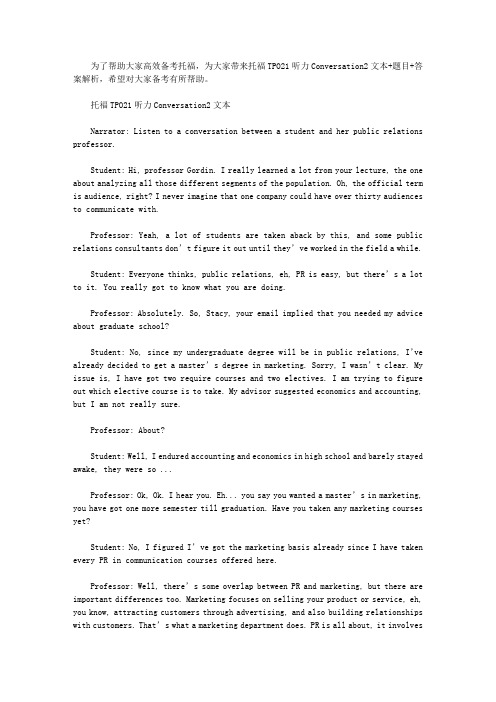
为了帮助大家高效备考托福,为大家带来托福TPO21听力Conversation2文本+题目+答案解析,希望对大家备考有所帮助。
托福TPO21听力Conversation2文本 Narrator: Listen to a conversation between a student and her public relations professor. Student: Hi, professor Gordin. I really learned a lot from your lecture, the one about analyzing all those different segments of the population. Oh, the official term is audience, right? I never imagine that one company could have over thirty audiences to communicate with. Professor: Yeah, a lot of students are taken aback by this, and some public relations consultants don’t figure it out until they’ve worked in the field a while. Student: Everyone thinks, public relations, eh, PR is easy, but there’s a lot to it. You really got to know what you are doing. Professor: Absolutely. So, Stacy, your email implied that you needed my advice about graduate school? Student: No, since my undergraduate degree will be in public relations, I’ve already decided to get a master’s degree in marketing. Sorry, I wasn’t clear. My issue is, I have got two require courses and two electives. I am trying to figure out which elective course is to take. My advisor suggested economics and accounting, but I am not really sure. Professor: About? Student: Well, I endured accounting and economics in high school and barely stayed awake, they were so ... Professor: Ok, Ok. I hear you. Eh... you say you wanted a master’s in marketing, you have got one more semester till graduation. Have you taken any marketing courses yet? Student: No, I figured I’ve got the marketing basis already since I have taken every PR in communication courses offered here. Professor: Well, there’s some overlap between PR and marketing, but there are important differences too. Marketing focuses on selling your product or service, eh, you know, attracting customers through advertising, and also building relationships with customers. That’s what a marketing department does. PR is all about, it involvesrelationships too.That’s why I am saying the two fields overlap. But in PR, you are developing relationships with a wider range of audiences. Student: Right. Like employees, suppliers, the media. I do understand this in theory, but aren’t you still selling your product, just in a different way? Professor: Not necessarily. Ok, do you remember that PR strategy I alluded to the other day? The one our university uses, a strategy that doesn’t overlap its marketing strategy? Student: You mean how the university invites local residents to attend certain lectures and classes for free? Professor: Yeah, this cultivates a sense of good will and helps the university avoid becoming isolated from the larger community. Bringing neighbours into our classrooms is good PR, but it is not marketing since our neighbours aren’t our customers, for the most part. Student: That’s why I want to focus on marketing in graduate school. Wouldn’t having expertise in PR and marketing giving me more career options? Professor: Yeah, but you’ll also want to enjoy your work. So for you electives, why don’t you take advertising principles and intro to marketing, which I teach? This way, you’ll find out if marketing is something you really want to pursue. Graduate School tuition is expensive, and these courses will give you a good overview of the field before committing yourself. Student: I wish my advisor had suggested those courses. Professor: Well, I am someone who has worked in both marketing and PR, so I can offer a different perspective than someone who only teaches. 托福TPO21听力Conversation2题目 1.Why does the woman go to see the professor? A. To ask which elective courses he will be teaching next semester. B. To get more advice on which elective courses to take next semester. C. To find out the difference between public relations and marketing D. To get help deciding whether to pursue a graduate degree in marketing 2.According to the professor,what aspect of public relations tends to surprise students? A. The fact that public relation does not involve advertising B. The high level of competition for jobs in the public-relations field. C. The number of groups that public-relations professionals reach out to D. The amount of education needed to work in the public-relations field. 3.According to the speakers,how does the university try to create a relationship with the surrounding community? A. By obtaining input from community members when developing new courses. B. By letting community members attend some lectures and classes without charge. C. By offering free career advice to community members D. By offering tuition discounts to community members 4.What does the professor imply when he mentions that graduate school is expensive? A. The woman may need to work part time while attending graduate school. B. The woman should shop around for an affordable graduate school. C. The woman could probably find employment in the marketing field without a graduate degree. D. The woman should make sure that her graduate course of study interest her. 5.Why does the professor say this: A. To convey understanding that the woman finds those subjects boring. B. To acknowledge that those subjects are too difficult for many high school students. C. To acknowledge that he has heard the same complaint from other students about those subjects. D. To assure her that those subjects are taught more effectively at the college level. 托福TPO21听力Conversation2答案解析 Q1题目解析: 正确答案:B My issue is, I have got two require courses and two electives. I am trying to figure out which elective course is to take 从女生的讲述来看,自己是在选课问题上在征求教授的意见。
托福TPO21听力Conversation1文本+题目+答案解析
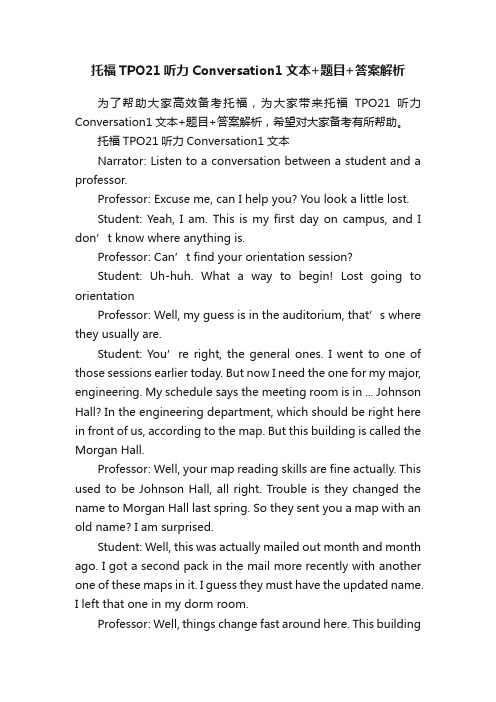
托福TPO21听力Conversation1文本+题目+答案解析为了帮助大家高效备考托福,为大家带来托福TPO21听力Conversation1文本+题目+答案解析,希望对大家备考有所帮助。
托福TPO21听力Conversation1文本Narrator: Listen to a conversation between a student and a professor.Professor: Excuse me, can I help you? You look a little lost.Student: Yeah, I am. This is my first day on campus, and I don’t know where anything is.Professor: Can’t find your orientation session?Student: Uh-huh. What a way to begin! Lost going to orientationProfessor: Well, my guess is in the auditorium, that’s where they usually are.Student: You’re right, the general ones. I went to one of those sessions earlier today. But now I need the one for my major, engineering. My schedule says the meeting room is in ... Johnson Hall? In the engineering department, which should be right here in front of us, according to the map. But this building is called the Morgan Hall.Professor: Well, your map reading skills are fine actually. This used to be Johnson Hall, all right. Trouble is they changed the name to Morgan Hall last spring. So they sent you a map with an old name? I am surprised.Student: Well, this was actually mailed out month and month ago. I got a second pack in the mail more recently with another one of these maps in it. I guess they must have the updated name.I left that one in my dorm room.Professor: Well, things change fast around here. This buildingwas renamed after one of our professors. She retired a few months ago. She is really well-known in the world of physics. Too bad for Johnson, I guess.Student: Who is Johnson anyway?Professor: Oh, one of the early professors here. Unfortunately, I guess his ideas are going out of style. Science kept marching forward.Student: I’ll say it does. That’s why I transferred to this university. I was really impressed with all the research equipment you guys have at the laboratories. You are really on the forefront.Professor: Um... so do you know what kind of engineering you want to specialize in?Student: Yeah, aerospace engineering.Professor: Well, the aerospace engineering department here is excellent! Eh... do you know that this university was the first one in the country to offer a program in aerospace engineering?Student: Yeah, I know. And a couple of students who graduated from here became astronauts and orbited the Earth.Professor: Right. The department has many prominent alumni. Well, you might end up taking some of your advanced math course with me.I get a lot of students from the engineering department because I teach the required applied mathematics courses.Student: Oh, cool. Actually, I want to get a minor in math.Professor: Excellent. Hmm... A major in aerospace engineering with a minor in math, you’ll go far with that degree. More of our students should do that. There are so many more opportunities available in the field when you have a strong math background.Student: I’m glad to hear you say that.托福TPO21听力Conversation1题目1.Why does the man need the professor's help?A. He does not know the location of his general orientation session.B. He lost the invitation to the engineering department's orientation session.C. He cannot locate the building for the department's orientation session.D. He needs help deciding which area of engineering he should specialize in.2.What is the cause of the man's problem?A. He did not allow enough time to find the location of his orientation session.B. He did not receive the orientation materials on time.。
- 1、下载文档前请自行甄别文档内容的完整性,平台不提供额外的编辑、内容补充、找答案等附加服务。
- 2、"仅部分预览"的文档,不可在线预览部分如存在完整性等问题,可反馈申请退款(可完整预览的文档不适用该条件!)。
- 3、如文档侵犯您的权益,请联系客服反馈,我们会尽快为您处理(人工客服工作时间:9:00-18:30)。
托福听写作业21
听写稿:(将听写稿复制到下面)
订正稿:(将订正稿复制到下面)
正确原文:
Today we’re going to continue our discussion of social insects, focusing on the Argentine ant, which, as you might guess, is a species of ant that’s native to Argentina. We'll consider what happened to this type of ant after some members of this species moved to California from their original habitat. OK, well, in Argentina, these Argentine ants behave like most ant species around the world. They fight other ants of the same species if those ants are from some other nest. But the Argentine ants living in California behave differently. Ants from different nests form a single large colony. Within this colony, there is little aggression among ants from different nests. And when they fight insects from outside their colony, the Argentine ants can quickly recruit a huge army from their network of nests. This of course gives them advantage over other ant species. So then, why do Argentine ants behave differently in California than they do in Argentina? Well, using genetic testing, researchers found that all the Argentine ants in California were very similar genetically. You see when the first Argentine ant came to California, their population must’ve been very small. And all the later generation of Argentine ants there must've descended from the same few ancestors. So they’re all closely related. This discovery is important because for most social insects, membership in a colony is based on how closely related they’re genetically.
生词摘录:
1.Argentine: adj. 阿根廷人(的)
2.Argentina: n. 阿根廷
3.ant: n. 蚂蚁
4.species: n. (单复数相同)物种,种类
5.habitat: n. 栖息地
6.nest: n. 巢,窝
7.colony: n. 群体,集群
8.aggression: n. 进攻,侵犯,侵略
9.recruit: v. 招募
10.n etwork: n. 网络
11.g enetic: adj. 基因的,遗传学的
12.g enetically: adv. 遗传学上
13.a ncestor: n. 祖宗,祖先
14.m embership: n. 会员身份(资格)。
